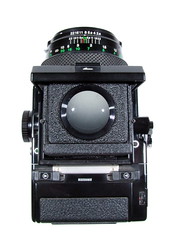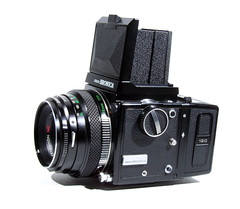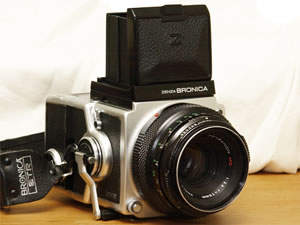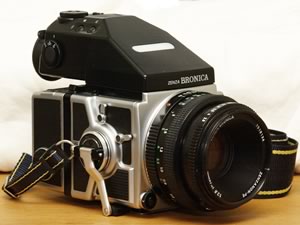The Zenza Bronica ETR is a series of 4.5×6 SLRs manufactured by The Zenza Bronica Industries Inc., Tokyo, Japan.
Original Zenza Bronica ETR specifications[]
This data belongs to the photos of the camera below.
- Produced between 1976-1980
- Medium format SLR film camera, film: 120 roll, 220 roll, picture size: 4.5x6cm
BODY[]
- Lens release: turn the lens clockwise when pressing the knob on the left lower front of the camera; the knob has a safety lock; the lens can be changed only when the shutter is cocked on the camera and on the lens
- Focusing: via matte ground glass screen with central bright area and fulll-area Fresnel lens, ring and scale on the lens, screen interchangeable by a lever under the finder
- Shutter: Seiko electronically controlled leaf shutter on the lens, speeds: 8-1/500; Mechanical control: speed 1/500, wo/battery
- Time exposure: Self-timer, via a lever on the lens
- Shutter release: knob on the lower right front of the camera, w/ a safety lock
- Cable release socket: on the lower left of the camera
- Cocking lever: folding crank, also winds the film, double exposure prevention;it is not work without the film in the camera
- Mirror: not instant return, cocking the camera is necessary for the mirror return
- Viewfinder: Waist level finder, interchangeable, w/ a magnifier lens, also interchangeable
- Flash PC socket: on the upper left front of the camera, w/a cap, synch. for X all speeds
- Dark slide:in a slot on the right side of the camera; when it is on the camera shutter can not be cocked, and the film magazine can be detached; when it is out of the camera shutter works. The dark slide is necessary to prevent the film from light when magazine changing
- Film magazine:interchangeable, the shutter must be cocked before changing the magazine
- Film loading: open the magazine cover and remove the film holder part with special holder shafts, load the film and put it back then slightly turn the manual winding folding lever on the right side of the magazine until film starting point mark of the film is alligned the triangular start mark on the film holder, close the magazine cover then turn the cocking crank until the number one is visible in frame counter window.
- Others: Speed-grip shutter release connection, Motor drive contacts, flash synch contact sockets on the special part of the bottom plate; Tripod socket: 1/4 inch; Strap knobs
- Body: metallic, Weight: 943g
- Battery: 6v silver oxide or Alkaline 4LR44, etc.; Battery test: small green led on top left of the camera and a button beneath it.
LENS[]
- Zenzanon MC 75mm f/2.8 with Seiko central leaf shutter, eletronically controlled by the body, 5 elements in 4 groups, multi-coated, (equivalent with 35mm is 46mm)
- Fully automatic instant re-opening diaphragm; Special Bronica mount, filter thread: 58mm; Focus range: 2-30m +inf; Aperture: f/2.8-f/22
- Time exposure lever on the lens, set to T, otherwise setting must be at A
- Weight: 426g

|
| Zenza Bronica ETR c.1978. Image by Süleyman Demir (Image rights) |
|
|
| ||||||
| Zenza Bronica ETR c.1978.
Images by Süleyman Demir (Image rights) | ||||||||
Zenza Bronica ETR-C[1][]
- Introduced October 1977
- Film magazine not removable, uses film inserts instead of interchangeable backs
- Otherwise the ETR-C is identical to the ETR
Zenza Bronica ETRS[1][]
Photo in: Flickr Camerapedia group
- Introduced January 1979
- Essentially the same as the ETR
- Added features:
- Electronic contact in the viewfinder to work with the metering display on the AE-II and AE-III finders
- Two position shutter release lock - locked, front release locked (for use with speed grip or motor winder), and all releases unlocked
- ETRS is in two versions:
- Early metal version with locking front lens release
- Later "plastic" ETRS with the lens release on the left side of the camera
Zenza Bronica ETRC[1][]
- Introduced January 1979
- ETRC is essentially the same as the ETRS
- Film magazine non-removable
- All of the improvements that made the ETRS different from the ETR are applied to this version of the ETRC
Zenza Bronica ETRS Modification[]
- Introduced July 1982
- Unnamed change of original ETRS model
- This version is sometimes referred to as the "plastic" body ETRS and back
- Lens release is on left side of body
- Film magazine release using two tabs
Zenza Bronica ETRSi[1][]

|
| Zenza Bronica ETRSi Image by Matthew Vanda Johnson (Image rights) |
- Introduced October 1989
- Improved version of ETRS
- Mirror lockup
- TTL flash metering
- Warning flag in the viewfinder when using multiple exposures
- Bulb shutter setting
- The advance mechanism is redesigned and greatly improved
- Capable of through-the-lens off-the-filmplane (TTL-OTF) flash exposure
- Improved back design (Ei) with locking darkslide
ETR series special editions[]
- ETR SP: Matching body, 120 back, and 75mm MC lens in black metal or silver chrome. All three components have "SP" designation, but otherwise seem identical to standard issue ETR parts.
- 20th Anniversary ETRS (probably 1979): Matching body, 120 back, and AE-II finder in black painted metal with brown leather.[2]
- ETRS Clubman (perhaps 1980 with the introduction of the SQ system): Matching body and AE-II finder in black painted metal, silver Clubman name plates, and lower rubber side panel reminescent of the newly introduced Bronica SQ camera system.
- Safari ETRS (sometime between 1982 and 1988): a surprisingly complete color-coordinated system with ETRS body, 75mm lens, 120 E back, AE-II finder, waist-level finder, speed grip, professional lens hood, and system case in green (possibly painted) polycarbonate with tan leather and accents. [3]
- Transparent Display ETRSi (likely made for the introduction of the ETRSi in 1989): Matching body and 120 back in transparent polycarbonate with no leather covering.[4]
- “William Fox Talbot the 150th Anniversary Special Edition” ETRSi (1990): Standard black polycarbonate ETRSi body with gold plaque below the shutter speed dial. Also came with Billingham Talbot 150 Year Hard Equipment Case (Holds Body, 2 Backs, 3 Lenses, Flash, Finder, and Motor Grip)
- “300,000 ETR Series Cameras Sold” ETRSi (Chrome Limited Edition, 1996): Matching body and 120 back in silver chrome polycarbonate with fine-grained black leather.[5]
- 40th Anniversary Limited Edition ETRSi (1999): Matching body, 75mm PE Lens, 120 Ei back, AE-III Finder, and Speed Grip all in champagne chrome polycarbonate (plastic) with grey leatherette— even the lens barrel is polycarbonate.
Chrome bodies and accessories[]
Throughout the life of the ETR line Bronica kept producing chrome bodies and backs, starting from the introduction in 1976. They made chrome ETR and ETRS bodies and chrome 120, 220, and 70mm backs probably until 1981 when they switched from metal body panels to polycarbonate. Then in 1996 they produced the Limited Edition chrome ETR-Si body and matching chrome Ei 120 back. The original chrome ETR and ETRS bodies came with chrome winding cranks, while the 1996 Limited ETRSi came with a standard black crank. Also the ETR and ETRS backs had chrome shells/frames and chrome inserts, while the 1996 chrome 120 backs had a standard black painted shell with a chrome insert.
An ETR manual that shows the original chrome components of the system is available online.[6]
There were never any chrome metal finders, though most of the pre-1981 finders seem to have been black painted metal just like the standard black bodies.
Confusingly, there was a later, champagne chrome colored polycarbonate 40th Anniversary edition that did have its own matching AE-III Finder, Speed Grip, and 75mm lens. This set uses grey instead of black leatherette. It is very pretty (and Bronica used its great original type and logo from the 60s)-- but it does not match any previous silver chrome components.
Original ETR and ETRS chrome bodies, backs, and cranks all look good and work well together with the other standard black components and the 1996 chrome Special Edition.[7]
One can replace the black plastic ME and MLU levers and the whole winder cover of the 1996 edition with metal chrome versions scavenged from any black metal paint ETR or early ETRS parts bodies. Doing so makes a thoroughly modern ETRSi body reminiscent of the Bronica S and S2 series -- and more importantly gives a very rugged, compact, modern medium format body.
Notes[]
- ↑ 1.0 1.1 1.2 1.3 The ETR series features are from Massimo Bertacchi's website Corsopolaris [1]
- ↑ See this page of Koh's Camera website.
- ↑ See this page of Koh's Camera website.
- ↑ See Josef Troszter's page in German [2]
- ↑ See this page, this page, and this page in Raymond Bradlau's pbase Camera gallery.
- ↑ Here at butkus.org.
- ↑ See Raymond Bradlau's photos referenced above for a pleasant example of mixing the 1996 chrome ETRSi with the older components.
Bibliography[]
- Lewis, Gordon, ed. The History of the Japanese Camera. Rochester, N.Y.: George Eastman House, International Museum of Photography & Film, 1991. ISBN 0-935398-17-1 (paper), ISBN 0-935398-16-3 (hard). P. 150.
- McKeown, James M. and Joan C. McKeown's Price Guide to Antique and Classic Cameras, 12th Edition, 2005-2006. USA, Centennial Photo Service, 2004. ISBN 0-931838-40-1 (hardcover). ISBN 0-931838-41-X (softcover). Pp. 159–62.
Links[]
General links[]
In English:
- in Corsopolaris by Massimo Bertacchi
- Bronica Users Group (BUG) at the Yahoo Groups site
- ETRSi Specifications and PE Lens Series Information at the Tamron Japan official website
- Bronica Discontinued Products List at the Tamron Japan official website
- Bronica ETR at medfmt
- Bronica ETRS/Si at medfmt
- Complete listing of ETR lens production from 1976 - 2004 on Bronica.net. Excel spreadsheet version.
- Bronica ETR website at myphotoweb.com (also in Dutch)
In Spanish:
In French :
In Japanese:
User manuals[]
- Bronica manuals at the Tamron official website, including the ETRS and ETRSi
- Bronica ETR manual and Bronica ETRS / ETRC manual at butkus.org





